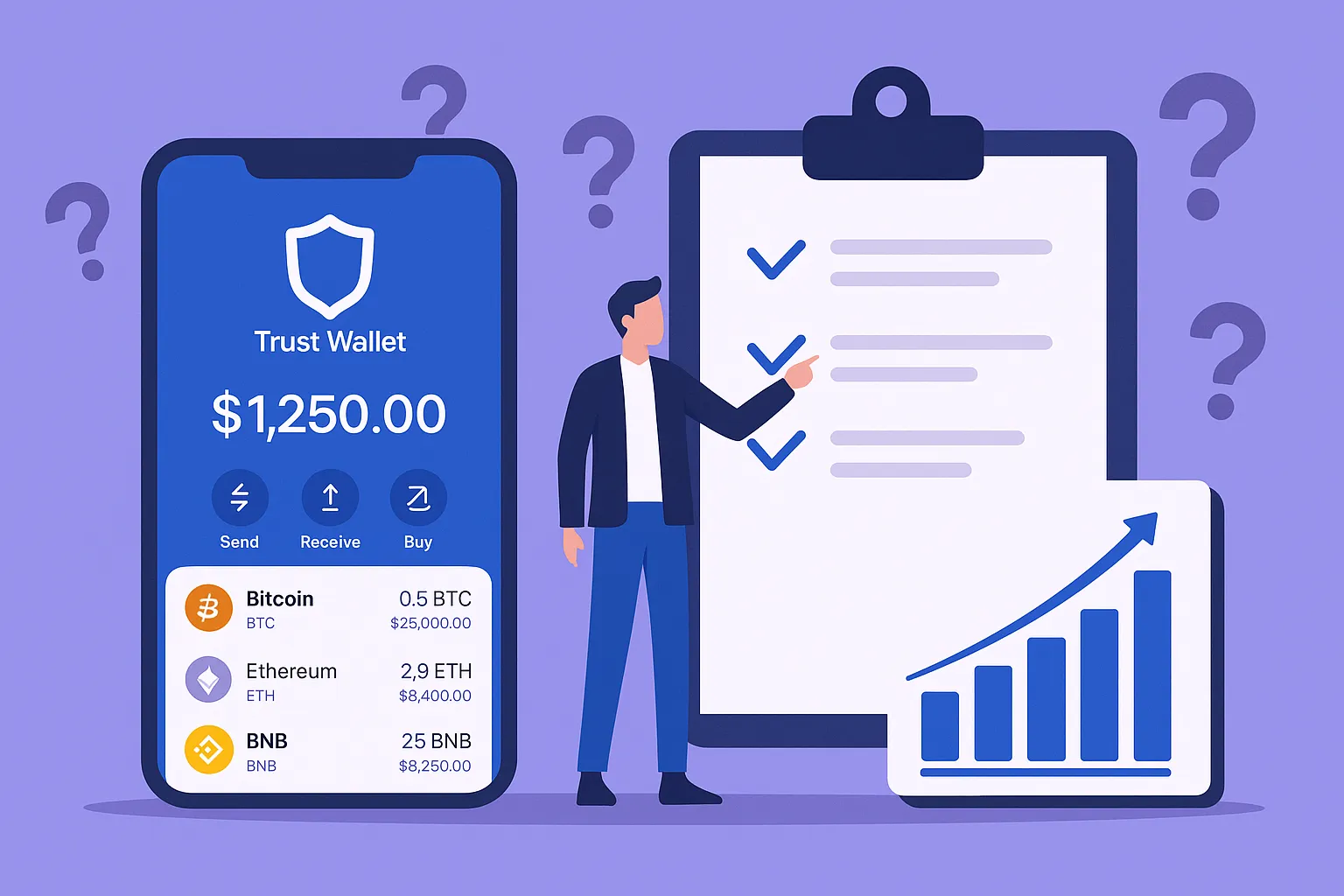Picture this: you finally cracked the product-market code for your Web3 venture, Trustwallet clone but every dev you call tells you a fully original crypto wallet will eat half your runway— and still need months of QA before it sees daylight. Sound familiar? Entrepreneurs everywhere face the same double-whammy of tight deadlines and soaring engineering costs. If you’ve ever felt that stomach-sink moment after hearing a shocking price quote, you’re not alone.
Luckily, there’s another road—one that doesn’t require selling your prized NFT to fund development. Cloning proven wallets like Trust Wallet lets founders focus on community, tokenomics, and growth instead of reinventing cryptographic wheels. From private-key storage to multi-coin swaps, you get the hard-coded goodies straight out of the box, then customize the flair your brand deserves. It’s the entrepreneurial version of “standing on the shoulders of giants”—minus the vertigo.
In this post we’ll unpack why more startups choose a Trustwallet clone over custom builds, reveal the hidden costs nobody talks about, and show how a clone actually protects your launch timeline. Along the way, we’ll sprinkle real-world stories, stats from heavy-hitters like Sensor Tower, and some healthy humor. Ready? Let’s dive in—Miracuves has your back.
What Is a TrustWallet Clone and How Does It Work?
A TrustWallet clone is a ready-made, customizable cryptocurrency wallet application that replicates the core features and functionality of the original Trust Wallet . It’s like getting a powerful engine already built, so you can focus on tuning the design, features, and business model to suit your goals—without reinventing cryptographic wheels.
How Does It Work?
- Blockchain Interaction:
Just like Trust Wallet, the clone connects directly to blockchains using remote procedure calls (RPCs) to fetch balances, submit transactions, or track tokens. - Key Management:
Users retain full control of their private keys or seed phrases. These are encrypted and stored locally—often protected by device biometrics or PIN locks. - Transaction Handling:
The clone uses cryptographic libraries to create, sign, and broadcast transactions. Users can send, receive, or swap tokens securely.
Read More : What is Trust Wallet App and How Does It Work?
Why Wallet Clones Beat Ground-Up Development
1. Speed That Doesn’t Sacrifice Security
Building a wallet from scratch means months of audits, penetration tests, and edge-case fixes. Trustwallet clone A clone starts with code already battle-tested by millions of users, hardened against phishing, replay attacks, and brute-force key guessing. Your devs can then layer in features like biometric 2FA or fiat on-ramps without touching the cryptographic core.
2. Total Cost of Ownership (TCO) Reality Check
Sure, you could budget for six backend engineers, two mobile engineers, and a security lead—plus AWS, GCP, or bare-metal servers. But the meter keeps running after launch: bug bounties, continuous integration costs, and compliance updates (hello, MiCA). With a clone, licensing plus incremental tweaks usually hover around 30-40 % of a scratch build across the first two years.
3. Proven UX Patterns Out of the Gate
Trust Wallet perfected the tap-to-swap gesture, the hexagonal token icons, and that comforting “backup your seed phrase” nudge at first launch. Trustwallet clone Users expect these cues; copy-pasting known patterns lowers friction and boosts retention. Think of it like road signs—no one wants to decode new symbols when they’re driving 100 km/h down crypto highway.
4. Interoperability & Ecosystem Perks
A Trust Wallet clone lands with native support for thousands of tokens and DApps thanks to WalletConnect. Trustwallet clone You instantly plug into DeFi, NFTs, and even on-chain games like Axie Infinity without separate SDK wrangling. Hypernym: mobile wallets; hyponyms: seed-phrase manager, HD wallet, watch-only mode. Holonyms? Your good old smartphone. Meronyms? QR-scanner, swap button, portfolio tab.
5. Community Trust & Word-of-Mouth
Crypto folks talk—a lot. When they see familiar login flows and encryption badges, they share screenshots on X (formerly Twitter) and Telegram. An original brand-new wallet often battles skepticism until audits pile up. A quality clone piggybacks on Trust Wallet’s reputation, earning goodwill faster. It’s the difference between jogging uphill and gliding on a moving walkway.
The Hidden Pitfalls of Custom Wallet Development
1. Reinventing the Wheel, Burning the Budget
Etymology break: “Cryptography” stems from Greek kryptós (hidden) and graphein (writing). Hiding secrets is ancient. Trying to rebuild AES encryption libraries when rock-solid open-source variants exist? That’s a pricey lesson in déjà-vu.
2. Security Talent Shortage
TechCrunch reported in April 2025 that blockchain security roles command an average salary premium of 35 % over general software engineers . Hunting for elite security minds might stall your roadmap for quarters, not days.
3. Regulatory Drift
While you code, rules shift. The EU’s MiCA law now mandates strict reporting of cross-border stablecoin transfers. A stalled project could launch outdated, risking fines. A clone vendor like Miracuves ships with compliance hooks baked in—think transaction-hash logs ready for regulators.
But Aren’t Clones “Just Copy-Paste”?
Nope. Cloning ≠ cloning sheep. The base code is your launchpad, but you’ll tweak:
- Brand personality (colors, mascots, witty error screens)
- Regional fiat gateways (think India’s UPI vs. Brazil’s Pix)
- Niche add-ons (staking dashboards, DAO voting)
- Premium upsells (NFT gallery, hardware-wallet sync)
Real-World Story: From Hackathon to 50k Users in 90 Days
An Indonesian startup, Moj Wallet (yes, named after “mojito”—they like puns), bootstrapped with a Trust Wallet clone. They added Bahasa Indonesia translations, Rupiah price feeds, and a “Shake-to-Share Referral” Easter egg. Sensor Tower data shows they hit 50 k installs by day 90 with a marketing spend under USD 12k. Custom build? Their CTO estimates it would have taken 7 months and USD 180k.
Competitive Edge: Feature Velocity
With the heavy cryptography done, your sprints focus on differentiators. Want an AI-powered “smart gas fee” predictor? Build that microservice and plug into the clone’s transaction module. Ship days, iterate daily—who doesn’t love some agile bragging rights?
Read More : Best Trustwallet Clone Scripts in 2025: Features & Pricing Compared
Conclusion
Wallet wars are heating up, but startups don’t need to reforge Excalibur just to enter the arena. A polished Trust Wallet clone offers speed, security, and savings while leaving room for your creative spark. As crypto UX trends toward embedded AI and multichain bridging, the ability to pivot quickly might be your biggest moat.
At Miracuves, we help innovators launch high-performance app clones that are fast, scalable, and monetization-ready. Ready to turn your idea into reality? Let’s build together.
FAQs
How customizable is a Trustwallet clone?
Very. Branding, fiat gateways, staking modules, and even dark-mode animations can all be tailored without touching the encryption core.
Will investors frown on a cloned product?
Most investors care about time-to-market and product-market fit. As long as you’re transparent about your tech stack and show unique value layers, they’re onboard.
How long does a typical clone project take?
We’ve seen MVPs go live in 3-9 days, versus 6–9 months for scratch builds.
Can I integrate hardware wallets?
Yes. We provide Ledger and Trezor bridges so users can store private keys offline while transacting through your mobile UI.
What about future token standards like ERC-4337 (account abstraction)?
Our architecture is modular. When new standards drop, we update modules so you get them with minimal downtime.
How does pricing work?
We charge a one-time license plus optional monthly support. No hidden gas—pun intended.
Related Article :








